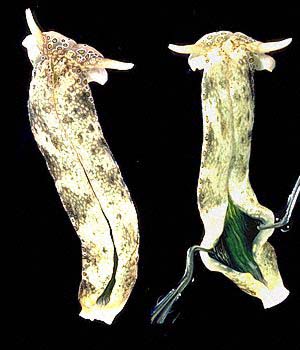
Plakobranchus ocellatus
van Hasselt, 1824
Order: SACOGLOSSA
Superfamily: ELYSIOIDEA
Family: Plakobranchidae
DISTRIBUTION
Found throughout the tropical Indo-West Pacific.
PHOTO
Animal on right with its parapodial flaps pulled open to show the longitudinal ridges which line the inside of the "parapodial cavity". The bright green colour is caused by the countless chloroplasts kept there by Plakobranchus.
Osterland Reef,Great Barrier Reef, August 1987. Length 5cm. PHOTO: Bill Rudman.
RELATED TOPIC
Plakobranchus ocellatus is a common inhabitant of shallow coral reef pools and lagoons. It is seldom seen as it is well-camouflaged, half buried in the coral sand. Although to my knowledge it has never been studied by algal physiologists, it deserves their attention. As I show in the photo above, it stores huge numbers of bright green chloroplasts in ridges hidden from view beneath the parapodial flaps. It may seem puzzling that this slug has evolved a method of storing chloroplasts, but at the same time shades them from the sunlight which would allow them to photosynthesise and provide nourishment for the slug. I have a theory, which is totally untested, that Plakobranchus deliberately shades the chloroplasts from the bright tropical sun. Most chloroplasts have an optimal light intensity at which they photosynthesise. They can be "burnt out" if exposed to too much light. By covering the chloroplasts with the parapodia, Plakobranchus rather than cutting the chloroplasts off from light, is just reducing the light levels to a better level for photosynthesis. I would love someone to test this hypothesis... Bill Rudman.
References:
• Hasselt, J.C.v. (1824). In: Andre Férussac. Extrait d'une lettre du Dr. J.C. van Hasselt au Prof. van Swinderen sur mollusques de Java (traduit de l'Allgem. konst en letterbode, 1824, nos. 2,3,4) Tjuringe (ile Java) le 25 Mai 1823 (1). Bulletin des Sciences Naturelle et de Geologie, 3: 237-248.
• Jensen, K.R. (1992). Anatomy of some Indo-Pacific Elysiidae (Opisthobranchia: Sacoglossa [=Ascoglossa]), with a discussion of the generic division and phylogeny. Mal. Soc. London, 58: 257-96.
Rudman, W.B., 1998 (December 11) Plakobranchus ocellatus van Hasselt, 1824. [In] Sea Slug Forum. Australian Museum, Sydney. Available from http://www.seaslugforum.net/find/placocel
Related messages
Plakobranchus ocellatus from Mayotte Island - 2d variation
October 22, 2009
From: Matthias Deuss
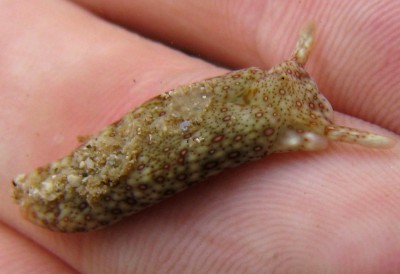
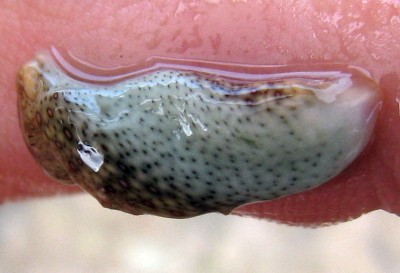
Dear Bill,
Here is the second colour variation of Plakobrachus I found. [see message #22643]. This one doesn't have a blue coloration of the foot and the rhinophores ; it bears small and big pink spots on the whole surface of the mantle (which is undoubtedly smooth, without pustules).
Locality: Moutsoumbatsou reef, 50 cm, Mayotte Is. , France, Indian Ocean, 03 September 2009, Sand and seagrass. Length: 15 mm. Photographer: Matthias Deuss
I found this slug just 200 meters from the last ones, on the same reef, in the same habitat.
Regards,
Matthias Deuss
matthias976@hotmail.fr
Deuss, M., 2009 (Oct 22) Plakobranchus ocellatus from Mayotte Island - 2d variation. [Message in] Sea Slug Forum. Australian Museum, Sydney. Available from http://www.seaslugforum.net/find/22644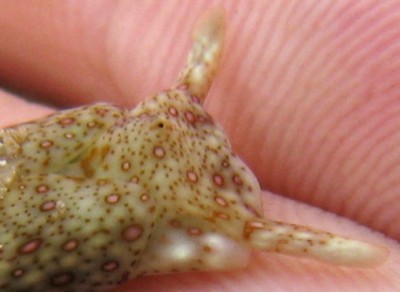
Thanks Matthias,
Best wishes,
Bill Rudman
Plakobranchus ocellatus from Mayotte Island - 1st variation
October 22, 2009
From: Matthias Deuss
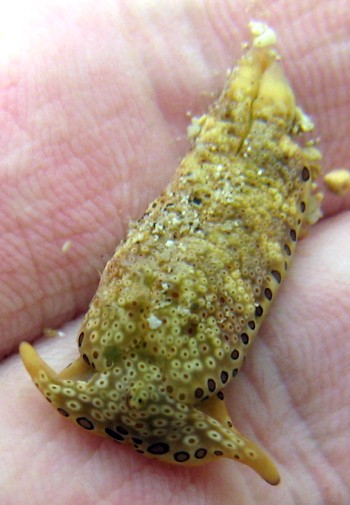
Dear Bill,
I found two different forms of Plakobranchus ocellatus today. As I understand there is a discussion of the number of species of Plakobranchus, I will present the second form in the next message [#22644 ].
This one was found mating with another one. As you can see their colour patterns were identical, as for the foot pattern. I can't say if its dorsum is covered with pustules or if it is a colour illusion. The very tips of the rhinophores are purple and the posterior extremity of the foot is blue.
The sides of the mantle bear the biggest spots.
Locality: Moutsoumbatsou reef, 50 cm, Mayotte Is. , France, Indian Ocean, 03 September 2009, Sand and seagrass. Length: 15 mm. Photographer: Matthias Deuss.
Kind regards
Matthias Deuss
matthias976@hotmail.fr
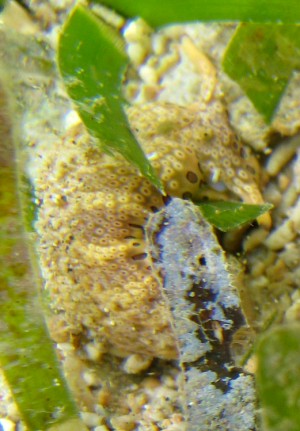
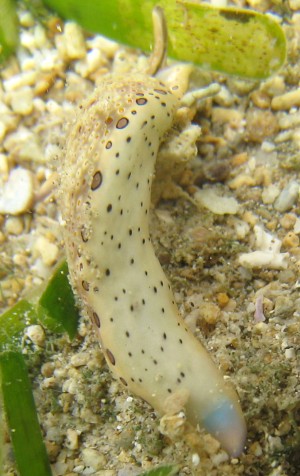
Thanks Matthias,
It's good to get a few more example of colour variation.
Best wishes,
Bill Rudman
Plakobranchus ocellatus? from Bali
October 27, 2008
From: Supapong Areeprasertkul
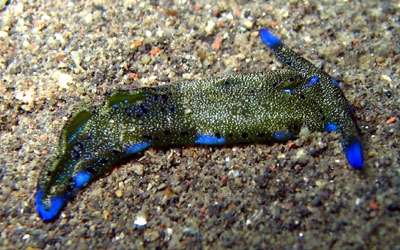
I tried to find the name of this sea slug, but do not found it in the list of Elysiidae. Is it Plakobranchus?
Locality: Beach, 10 metres, Puri Jati, Bali, Indonesia, Bali, 16 August 2007, Sandy bottom. Length: 4 cm. Photographer: Nattapon Annanon.
Supapong Areeprasertkul
zybersup@gmail.com
Supapong, A., 2008 (Oct 27) Plakobranchus ocellatus? from Bali . [Message in] Sea Slug Forum. Australian Museum, Sydney. Available from http://www.seaslugforum.net/find/20566Dear Art,
This is a species of Plakobranchus, and as I have discussed before, we generally consider there to be the single species - Plakobranchus ocellatus - but we could be wrong. If there is more than one species, this is possibly the same as Lindsay Warren's animal [message #2135].
Best wishes,
Bill Rudman
Re: Plakobranchus ocellatus from Vietnam?
March 6, 2008
From: Hua Thai Tuyen
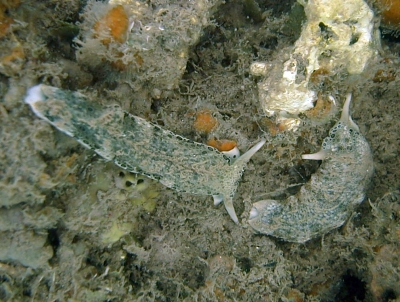
Concerning message #17041:
This may be the same species
Locality: Danang City, 5m, Vietnam, South China sea, 08 Jun 2005, Coral reef. Length: 60 mm. Photographer: Hua Thai Tuyen.
Hua Thai Tuyen
hthaituyen@yahoo.com
Hua Thai Tuyen, 2008 (Mar 6) Re: Plakobranchus ocellatus from Vietnam?. [Message in] Sea Slug Forum. Australian Museum, Sydney. Available from http://www.seaslugforum.net/find/21422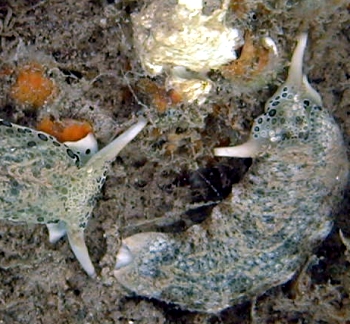
Dear Tuyen,
Yes this is Plakobranchus ocellatus.
Best wishes,
Bill Rudman
Plakobranchus ocellatus from the Philippines
August 15, 2006
From: Charles Raabe
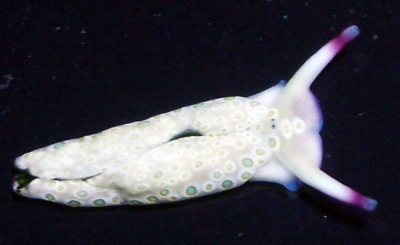
I thought this was an interesting find and would like to know its species if possible.
Locality: Mactan Island, 2 feet, Philippines, Camotes Sea, 08 August 2006, Reef Flat. Length: 1/2 Inch. Photographer: Charles Raabe.
Charles Raabe
charlesr1958@pacific.net.ph
Raabe, C., 2006 (Aug 15) Plakobranchus ocellatus from the Philippines. [Message in] Sea Slug Forum. Australian Museum, Sydney. Available from http://www.seaslugforum.net/find/17395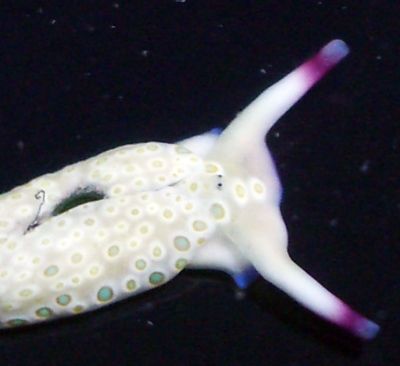
Dear Charles,
This isPlakobranchus ocellatus, a sacoglossan sea slug which lives in coral sand in fairly shallow water. Although a number of names exist for various colour forms, the general consensus is that there is only one species. That is not to say that future work will not recognise more species. Have a look at the Fact Sheet and other related messages to find out more about the biology of this interesting sea slug.
Like species of Elysia, it has a pair of flaps [parapodia ] which fold over the back of the animal. The green patch you can see in your photo is from the green ridges, packed full of microscopic chloroplasts, which line the inside of the parapodia. See the Solar-powered sea slug Fact Sheet for further information.
Best wishes,
Bill Rudman
Plakobranchus ocellatus from Vietnam?
July 13, 2006
From: Mike Krampf

Can you ID this one? Is it Plakobranchus ocellatus? Sorry for the poor quality pic
Locality: Dive Site - Bai Su off Whale Island, 35 feet, North of Nha Trang, Vietnam, South China Sea, 28 June 2006, Boulders near shoreline with lots of silt. Length: 3-4 cm. Photographer: Mike Krampf.
Thanks,
Mike
mtkrampf@yahoo.com
Krampf, M., 2006 (Jul 13) Plakobranchus ocellatus from Vietnam?. [Message in] Sea Slug Forum. Australian Museum, Sydney. Available from http://www.seaslugforum.net/find/17041Dear Mike,
At present only one species, P. ocellatus is generally recognised. If later studies do show there is more than one species, yours is the one with distinctively bluish purple tips to the rhinophores [See Atsushi Ono's variation E - message #13983 ].
Best wishes,
Bill Rudman
Re: Plakobranchus ocellatus kind of mating
February 2, 2006
From: Rokus Groeneveld
Concerning message #15576:
Dear Bill,
Thanks again. It must be an enormous task to share you're enormous knowledge day after after day with all those people having all those questions. And you're a great observer to. I hadn't seen the penis of the second animal untill now. I'll start looking better.
Best regards,
Rokus G.
rosa12@wxs.nl
Groeneveld, R., 2006 (Feb 2) Re: Plakobranchus ocellatus kind of mating. [Message in] Sea Slug Forum. Australian Museum, Sydney. Available from http://www.seaslugforum.net/find/15730Plakobranchus ocellatus kind of mating
January 30, 2006
From: Rokus Groeneveld
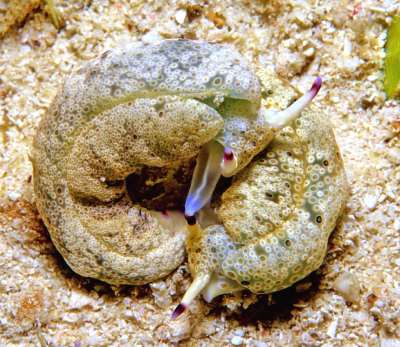
Dear Bill,
This question is not about the species this time. I know it's Plakobranchus ocellatus. But I observed them for a while, hoping they would mate. One certainly tried to, but as you can probably see, he (she?) tried to connect to the rhinophores. Is that a mistake that happens more often? Anyway, that's as far as they got while I was watching.
Locality: Cabilao Island, Philippines, Visayan Sea. Depth: about 15 meters, Length: about 6 centimeters?. 23 December 2005. sandy slope. Photographer: Rokus Groeneveld
Thanks again in advance, best regards,
Rokus Groeneveld
Netherlands
rosa12@wxs.nl
Rokus G., 2006 (Jan 30) Plakobranchus ocellatus kind of mating. [Message in] Sea Slug Forum. Australian Museum, Sydney. Available from http://www.seaslugforum.net/find/15576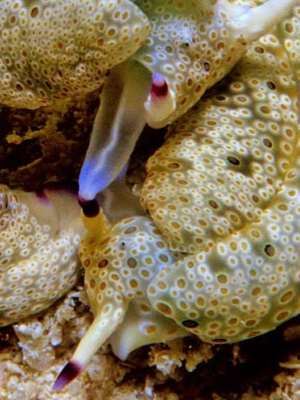
Dear Rokus,
I think mating with the rhinophore is an error. However sacoglossans have quite complex and strange mating behaviours which differ between species and families. Some have a spine at the end of the penis and can inject sperm through the skin and body wall into the body cavity. However I am pretty sure Plakobranchus has a female genital opening on the right side of the body just in front of the parapodia. It looks like the penis of the lower animal is pointed in the right direction.
Best wishes,
Bill Rudman
Re: Plakobranchus ocellatus variation
June 10, 2005
From: Rie Nakano
Dear Dr.Rudman,
Here is a reference to the article mentioned in Atushi's message [#13970]
Yamasu, T. (1997) Umiushi Tsushin. Research Institute of Marine Invertebrates, Japan, 17: 5-8.
This paper has no English title. If I translate this literally into English, it becomes "Concerning the Sacoglossan speciation ". Yamasu wrote only a few lines explaining the differences of the foot in a Table on p. 8.
Sincerely,
Rie
rie@divers.ne.jp
Nakano, R., 2005 (Jun 10) Re: Plakobranchus ocellatus variation. [Message in] Sea Slug Forum. Australian Museum, Sydney. Available from http://www.seaslugforum.net/find/14003Thanks Rie,
Best wishes,
Bill Rudman
Plakobranchus ocellatus - variation F
June 8, 2005
From: Jun Imamoto


Dear Bill,
I heard from Atsushi and to accompany his message [#13970] discussing the variations of Plakobranchus ocellatus he has observed at Kerama Is, I have attached images of a common form seen in Amami-Ooshima Islands in Japan. The photo is of a 9 mm individual but I have also seen 20 mm long individuals wit the same pattern.
Locality: Amami-Ooshima Islands, The Dong Hai, Kagoshima, Japan. Depth: 1 m. Length: 9 mm. 20 Mar 2005. On top of pebbles which have become covered with mud. Photographer: Jun Imamoto
Best Regards,
Jun Imamoto
http://www.umiushi.info/
imamoto@umiushi.info
Imamoto, J., 2005 (Jun 8) Plakobranchus ocellatus - variation F. [Message in] Sea Slug Forum. Australian Museum, Sydney. Available from http://www.seaslugforum.net/find/13878Dear Jun,
Thanks very much for these photos. To fit with Atsushi Ono's messages, I have called your colour form Var. F.
His colour variations are posted as separate messages:
Var. A = message #13979
Var. B = message #13980
Var. C = message #13981
Var. D = message #13982
Var. E = message #13983
Best wishes,
Bill Rudman
Plakobranchus variation - how many species?
June 8, 2005
From: Atsushi Ono
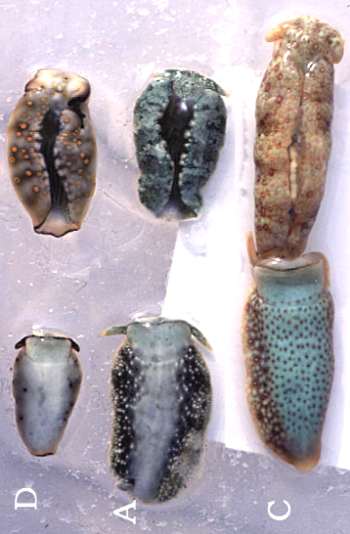
Dear Bill,
There is short Japanese report (Yamasu, 1997) which refers to the possibility that Plakobranchus ocellatus may consist of more than one species on the main Okinawa island. However, photographs of dorsal view are not so clear in this report and there are no photograph of the foot.
Since then, I have observed many Plakobranchus ocellatus in Kerama Is. They seem to be divided into five forms. A,C and D are seen in the same area - shallow lagoon. These results do not necessarily correspond to Yamasu, 1997. In addition, another form was found on both the main Okinawa island and Amami Oshima Is. [See separate message #13878 from Jun Imamoto]. I think that the pattern on the foot is especially important. I think that these different 'forms' suggest more research is required to determine how many species there actually are.
The colour patterns are posted as separate messages:
Var. A = message #13979
Var. B = message #13980
Var. C = message #13981
Var. D = message #13982
Var. E = message #13983
Var. F = message #13878
Sincerely,
Atsushi Ono
ononini@cosmos.ne.jp
Ono, A., 2005 (Jun 8) Plakobranchus variation - how many species?. [Message in] Sea Slug Forum. Australian Museum, Sydney. Available from http://www.seaslugforum.net/find/13970Dear Atsushi,
Thanks for this interesting contribution. Can you give me a reference to Yamasu's publication please? I am sure many of us have noticed the variability in Plakobranchus so it is nice to have it sorted out in this way. Many names have been given to Plakobranchus so if it is shown in the future that there is more than one species, I hope the old names were well enough described to allow us to decide which name refers to which colour 'variation'.
I agree that the colour on the sole of the foot is interesting. I also noticed when looking at your photos that in some the green network of digestive gland tubules are clearly visible on the underside of the head in some but not others. I have often wondered if variability in this species - at least dorsally is cirrelated with the environment. For example are those living in white coral sand always very white so they are well camouflaged, and do those living in more muddy environments have a darker appearance. Also chloroplast symbiosis is an important aspect of their biology. Perhaps colour variability is associated with the needs of the chloroplasts?
I suspect this relatively common species, or group of species, has many secrets for us to unravel.
Best wishes,
Bill Rudman
Plakobranchus ocellatus - variation A
June 8, 2005
From: Atsushi Ono
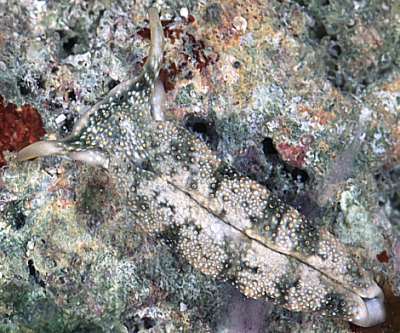
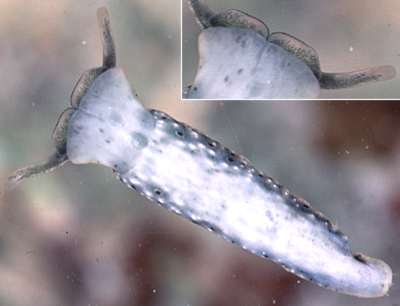
In a separate message [#13970] I discuss the variations of Plakobranchus ocellatus I have observed at Kerama Is. They seem to be divided into five forms. Here are photos of Form A. I think that the pattern of foot is especially important and I think that these different 'forms' suggest more research is required to determine how many species there actually are.
The other colour variations are posted as separate messages:
Var. B = message #13980
Var. C = message #13981
Var. D = message #13982
Var. E = message #13983
Var. F = message #13878
Sincerely,
Atsushi Ono
ononini@cosmos.ne.jp
Ono, A., 2005 (Jun 8) Plakobranchus ocellatus - variation A. [Message in] Sea Slug Forum. Australian Museum, Sydney. Available from http://www.seaslugforum.net/find/13979Plakobranchus ocellatus - variation B
June 8, 2005
From: Atsushi Ono
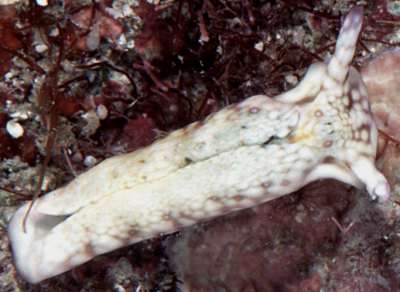
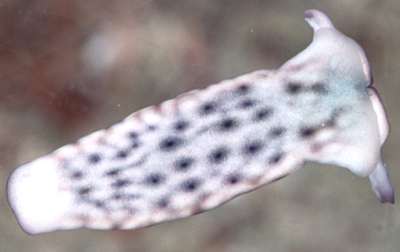
In a separate message [#13970] I discuss the variations of Plakobranchus ocellatus I have observed at Kerama Is. They seem to be divided into five forms. Here are photos of Form B. I think that the pattern of foot is especially important and I think that these different 'forms' suggest more research is required to determine how many species there actually are.
The other colour variations are posted as separate messages:
Var. A = message #13979
Var. C = message #13981
Var. D = message #13982
Var. E = message #13983
Var. F = message #13878
Sincerely,
Atsushi Ono
ononini@cosmos.ne.jp
Ono, A., 2005 (Jun 8) Plakobranchus ocellatus - variation B. [Message in] Sea Slug Forum. Australian Museum, Sydney. Available from http://www.seaslugforum.net/find/13980Plakobranchus ocellatus - variation C
June 8, 2005
From: Atsushi Ono
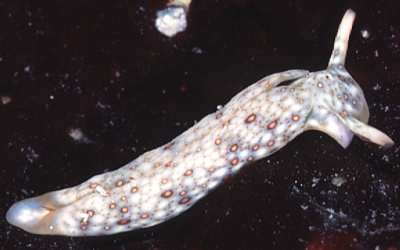
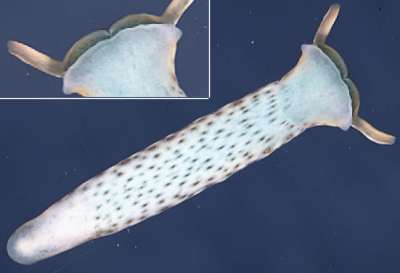
In a separate message [#13970] I discuss the variations of Plakobranchus ocellatus I have observed at Kerama Is. They seem to be divided into five forms. Here are photos of Form C. I think that the pattern of foot is especially important and I think that these different 'forms' suggest more research is required to determine how many species there actually are.
The other colour variations are posted as separate messages:
Var. A = message #13979
Var. B = message #13980
Var. D = message #13982
Var. E = message #13983
Var. F = message #13878
Sincerely,
Atsushi Ono
ononini@cosmos.ne.jp
Ono, A., 2005 (Jun 8) Plakobranchus ocellatus - variation C. [Message in] Sea Slug Forum. Australian Museum, Sydney. Available from http://www.seaslugforum.net/find/13981Plakobranchus ocellatus - variation D
June 8, 2005
From: Atsushi Ono
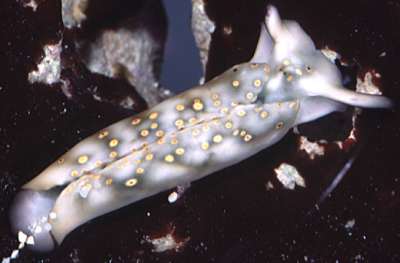
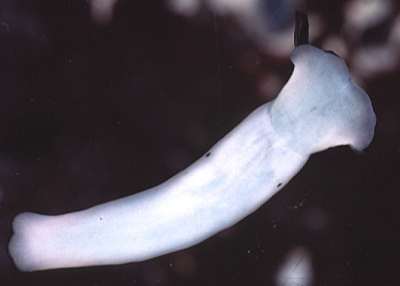
In a separate message [#13970] I discuss the variations of Plakobranchus ocellatus I have observed at Kerama Is. They seem to be divided into five forms. Here are photos of Form D. I think that the pattern of foot is especially important and I think that these different 'forms' suggest more research is required to determine how many species there actually are.
The other colour variations are posted as separate messages:
Var. A = message #13979
Var. B = message #13980
Var. C = message #13981
Var. E = message #13983
Var. F = message #13878
Sincerely,
Atsushi Ono
ononini@cosmos.ne.jp
Ono, A., 2005 (Jun 8) Plakobranchus ocellatus - variation D. [Message in] Sea Slug Forum. Australian Museum, Sydney. Available from http://www.seaslugforum.net/find/13982Plakobranchus ocellatus - variation E
June 8, 2005
From: Atsushi Ono


In a separate message [#13970] I discuss the variations of Plakobranchus ocellatus I have observed at Kerama Is. They seem to be divided into five forms. Here are photos of Form E. I think that the pattern of foot is especially important and I think that these different 'forms' suggest more research is required to determine how many species there actually are.
The other colour variations are posted as separate messages:
Var. A = message #13979
Var. B = message #13980
Var. C = message #13981
Var. D = message #13982
Var. F = message #13878
Sincerely,
Atsushi Ono
ononini@cosmos.ne.jp
Ono, A., 2005 (Jun 8) Plakobranchus ocellatus - variation E. [Message in] Sea Slug Forum. Australian Museum, Sydney. Available from http://www.seaslugforum.net/find/13983Plakobranchus ocellatus from Vanuatu
February 20, 2004
From: Hugh Dickson
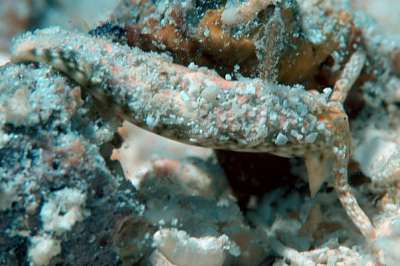
I wonder if you can ID this animal for me? I think it may be Plakobranchus ocellatus.
Location is off Aore Island [on Cindy's Reef], Espiritu Santu, Vanuatu. About 3 cm. Sandy bottom at about 30 ft. Dec 2003 Hugh Dickson
hugh.dickson@attglobal.net
Dickson, H., 2004 (Feb 20) Plakobranchus ocellatus from Vanuatu. [Message in] Sea Slug Forum. Australian Museum, Sydney. Available from http://www.seaslugforum.net/find/12249Dear Hugh,
Yes this is Plakobranchus ocellatus. It can be quite variable in colour, as your pinky orange example shows.
Best wishes
Bill Rudman
Plakobranchus ocellatus from Malaysia
October 3, 2003
From: Asther M. Lau
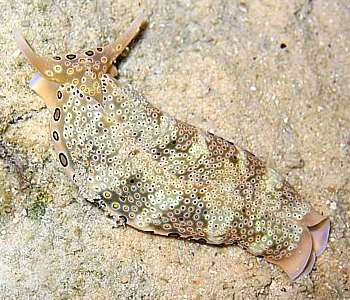
Dear Bill,
Can you help in identifying this weird one. I found it during a night walk down the beach at Perhentian Island, Terengganu, Malaysia. It was low tide and we were walking among the rocks and sand to look for octopuses when I came across so many of this slug hidden underneath the sand.
Water was just ankle deep. I suspect this one eats flat worms too?
Thank you,
Asther M. Lau
diveworldwide@yahoo.com
Lau, A.M., 2003 (Oct 3) Plakobranchus ocellatus from Malaysia. [Message in] Sea Slug Forum. Australian Museum, Sydney. Available from http://www.seaslugforum.net/find/11043Dear Asther,
Your mystery animal is the sacoglossan sea slug Plakobranchus ocellatus. It is related to Elysia and is often found on shallow sandflats. Rather than feeding on flatworms, it is a herbivore, but like many of its relatives it keeps plant chloroplasts alive in its body. Have a look at the Solar-powered sea slugs page. If you look at the species Fact Sheet you will see a photo showing how you can partially unfold the parapodia to see the green ridges on the body where the chloroplasts are stored.
Best wishes
Bill Rudman
Nudibranch or Flatworm from Hawaii
March 11, 2003
From: Pauline Jacobson
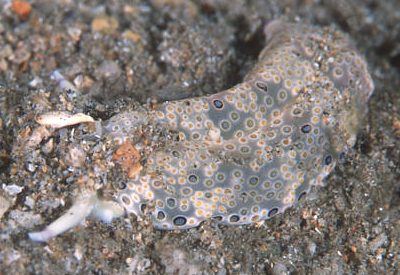
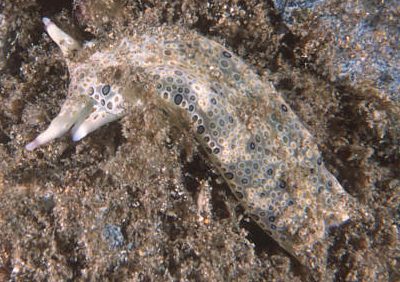
I photographed this nudibranch or flatworm in Maui, Hawaii at the Turtle Town dive site in Waialea, November, 2001 at approx 20 ft. on a sandy bottom.
Can you please identify it? I have not been able to find any photos that are similar. There were many of them, they appeared to have gathered in large numbers to mate.
Pauline Jacobson
pauline@cdislands.com
Jacobson, P., 2003 (Mar 11) Nudibranch or Flatworm from Hawaii. [Message in] Sea Slug Forum. Australian Museum, Sydney. Available from http://www.seaslugforum.net/find/9295Dear Pauline,
Your mystery animal is the sacoglossan sea slug Plakobranchus ocellatus. They are often found in quite dense populations but I don't know if they aggregate to mate. The sacoglossans feed by sucking the cell sap out of algae. Some, such as Plakobranchus ocellatus, keep the chloroplasts from the algae alive in their own bodies, where they continue to photosynthesise - converting the sun's energy into sugars. Have a look at the Solar-powered Sea Slug page for more information on this remarkable symbiosis.
Best wishes,
Bill Rudman
Tom Wyatt's Plakobranchus message
January 18, 2003
From: Mary Middlebrook
Bill,
The photo of what you have identified as Plakobranchus is one that I personally took at my import facility and it definitely came from Tonga. I don't know who Tom Wyatt is and why he's making claims about it's origin and how it came in. The Tonga exporter is claiming that it eats flatworms, although I have personally not witnessed this since I'm not plagued by the creatures!
Thank you,
Mary Middlebrook
http://www.reefsource.com/
marinewholesale@hotmail.com
Middlebrook, M, 2003 (Jan 18) Tom Wyatt's Plakobranchus message. [Message in] Sea Slug Forum. Australian Museum, Sydney. Available from http://www.seaslugforum.net/find/8958Thanks for clearing up the origin of the animal. I guess Mr Wyatt must have copied the photo from your website. Anyway my comments are still the same. I can assure you that
Best wishes,
Bill Rudman
Plakobranchus ocellatus in aquaria
January 15, 2003
From: Tom Wyatt

Hi Bill,
The following is some sort of color variant of Notodoris serenae I think, but I would like a little better opinion (read this as info from a more experienced eye than mine) for ID and any feeding info that you might have. It has been observed eating acoel flatworms and is most likely from Indonesian waters at a depth of less than 1 to possibly 6m, although I cannot give you much more information than that, as it was a hitch hiker on collected rock.
Any suggestions/comments?
Tom Wyatt
tdwyatt@aol.com
Note: see message from Mary Middlebrook stating photo is hers of an animal from Tonga.
Dear Tom,
It's definitely not a species of Notodoris. It is a sand-dwelling species of sacoglossan sea slug called Plakobranchus ocellatus. I would be interested in hearing more about it eating acoel flatworms as sacoglossans are herbivorous, that is they feed on algae, and many, including Plakobranchus store functional chloroplasts from the algae in their own bodies. See the page on Solar powered animals for more information. I am not actually sure what algae Plakobranchus feeds on to obtain its chloroplasts. Some flatworms also have symbiotic chloroplasts in their bodies. It would indeed be interesting, if highly unlikely, if Plakobranchus obtained its chloroplasts by ingesting 'solar-powered' flatworms. I look forward to hearing more about your observations,
Best wishes,
Bill Rudman
Plakobranchus from French Polynesia
October 22, 2001
From: Daniel Geiger

Hi Bill
Here are some photos of Plakobranchus from French Polynesia. Moorea, August 2001. body approx. 1 cm.
Daniel.
dgeiger@nhm.org
Geiger, D., 2001 (Oct 22) Plakobranchus from French Polynesia. [Message in] Sea Slug Forum. Australian Museum, Sydney. Available from http://www.seaslugforum.net/find/5436Thanks Daniel,
At present, all the colour variants are considered to be forms of Plakobranchus ocellatus. From my experience, small specimens like yours have a much denser covering of opaque white than larger animals.
Best wishes,
Bill Rudman
Plakobranchus from Thailand
December 27, 2000
From: Dave Harasti
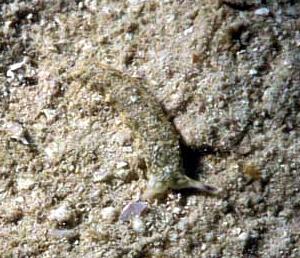
Bill,
I took these photo's of this unknown Nudibranch in late October 2000. It was at Koh Tao Island in Thailand, the depth was about 6 metres and it was moving across barren sand. The closest bommie was about 20 metres away. The nudibrnach was about 5 cms in length. I've looked through all my books and can't identify it, can you help?
Thanks,
Dave Harasti
http://www2.dynamite.com.au/davidh/index.htm
davidh@dynamite.com.au
Harasti, D., 2000 (Dec 27) Plakobranchus from Thailand. [Message in] Sea Slug Forum. Australian Museum, Sydney. Available from http://www.seaslugforum.net/find/3365Dear David,
This is Plakobranchus ocellatus, which is common throughout the tropical Indo-West Pacific in relatively shallow sandy environments. It is one of the many sacoglossan sea slugs which are 'solar powered' with symbiotic chloroplasts allowing it to photosynthesise like a plant.
Bill Rudman.
Blue-bellied plakobranchs
June 14, 2000
From: Mary Jane Adams
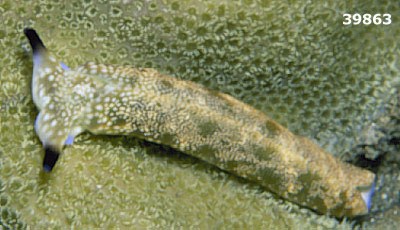
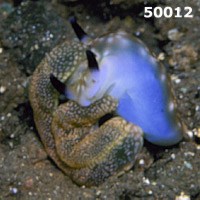
Dear Bill,
All the Plakobranchus I have seen in Papua New Guinea look like the ones in Lindsay Warren's photo from Sulawesi. They are olive green with light spots and black rhinophores. They do not have the ocellated pattern I always see in photos labeled Plakobranchus ocellatus. The foot on the Plakobranchs in my photos from Milne Bay and New Hanover varies from cream colored to bright blue.
#39863 Luadi, Milne Bay, length=28mm, depth= 5 meters, March 26, 1998
#50012 Luadi, Milne Bay, depth=5 meters, May 18, 2000
Best regards,
Mary Jane
mjadams@earthlink.net
Adams, M.J., 2000 (Jun 14) Blue-bellied plakobranchs. [Message in] Sea Slug Forum. Australian Museum, Sydney. Available from http://www.seaslugforum.net/find/2533Dear Mary Jane,
It would probably be interesting to compare the anatomy of the different colour forms of Plakobranchus, and there are a few names that have been given to different colour forms, but at present the general feeling is that there is only one widespread species.
Best wishes,
Bill Rudman.
Another species? of Plakobranchus
March 25, 2000
From: Lindsay Warren
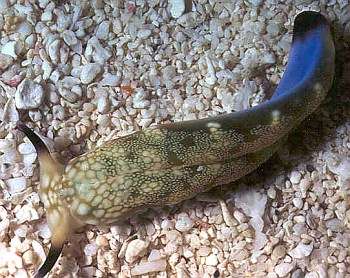

Dear Bill
I first found this Plakobranchus (OWN47) during 1998. However, the photos here are just two of 41 found last season between May and November 1999 on small sand slopes in the walls of Pulau Hoga and occasionally on Pulau Kaledupa [Tukang Besi Archipelago, SE Sulawesi, Indonesia - Operation Wallacea]. Size: 25 - 50 mm.
I have normally found them in pairs or groups of up to 8 in a very small area (40 cm sq) with their heads buried in the sand. Initially, from a distance of 6 ft, I thought it was only a detached piece of encrusted sea grass but I just happened to flip one over with my fin and saw the striking blue underside to the foot running along its entire length which is characteristic of this species. The upper part of the body and parapodia are olive green covered in white spots of varying size. The head tends to be more brown with larger white spots. The rhinophores are simple, pointed with white or beige lower half and black upper half. On one occasion I found a pair getting closer together and ending up curled round each other for some time - presumably mating. Sadly I did not have my camera with me.
I don't think it could be P. ocellata as there is no mention of the blue foot in descriptions I have read and the parapodia markings are quite different as are the rhinophore colours. Do you know this one?
All the best
Lindsay Warren
100014.2112@compuserve.com
Warren, L., 2000 (Mar 25) Another species? of Plakobranchus. [Message in] Sea Slug Forum. Australian Museum, Sydney. Available from http://www.seaslugforum.net/find/2135Dear Lindsay,
I do know this animal but my understanding is that it is considered a colour form of Plakobranchus ocellatus. I am not an expert on these sacoglossans so I will leave any further comment on their identity. Hopefully someone can help us out.
Best wishes,
Bill Rudman.
Re: original description of Plakobranchus
January 25, 1999
From: Bill Rudman
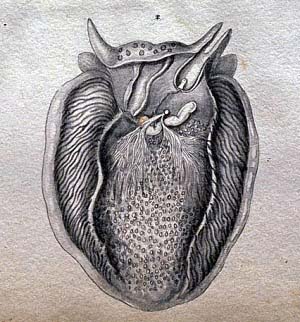
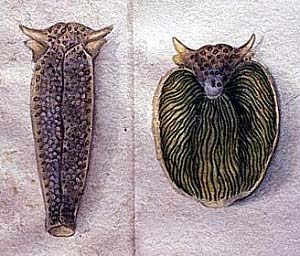
I have found a copy of the original description in Dutch which Richard Willan referred to in his message about the spelling of Plakobranchus. I accept that Placobranchus is an error and think I have changed all the spellings of the name on the Forum, except in the "messages". Except for my typing errors, I don't plan to alter published messages. In that way, they can be used and cited in other publications.
Out of interest I have included photos of three unpublished illustrations of van Hasselt's which were lent to me by Bob Burn, who has copies from the Leiden Museum, Holland. The upper one is of a dissected specimen showing the reproductive system and the ducts of the digestive gland. In his original description, van Hasselt gives a lengthy description of the anatomy of Plakobranchus, and in particular, the reproductive system.
Bill Rudman.
Re: Plakobranchus mating
January 25, 1999
From: Erwin Koehler
Dear Bill,
at page 20 of "Hawaiian Nudibranchs, Hans Bertsch and Scott Johnson" is a photo "copulating pair of Plakobranchus" almost the same position as my photo shows it.
Erwin
E.Koehler@deutschepost.de
Koehler, E., 1999 (Jan 25) Re: Plakobranchus mating. [Message in] Sea Slug Forum. Australian Museum, Sydney. Available from http://www.seaslugforum.net/find/512Thanks Erwin,
By coincidence I've just posted a message answering your query about the correct spelling of Plakobranchus. Sacoglossans are very interesting in their mating behaviour. Some species don't have a functional vagina and others don't seem to use it even when it is open! These species have evolved a method of "hypodermic impregnation" whereby a hardened penial stylet pierces the body wall of the partner and injects a parcel of sperm. I am not sure what Plakobranchus does.
Bill Rudman.
Re: Placo- or Plakobranchus?
January 4, 1999
From: Richard Willan
Dear Bill,
There is an interesting story here and because Placobranchus is a misspelling (technically an invalid emendation), I have changed (actually reverted) to using Plakobranchus for the genus and Plakobranchidae for the family. Kathe Jensen (1997: 62) gives the following explanation:
Hasselt's (1824) original description of Plakobranchus ocellatus was published in a Dutch journal Algemeene Konst- en Letterbode but it was translated into French the same year by M. Boie who, in error, transcribed Plakobranchus as Placobranchus. It is this translation, "Extrait d'une lettre de J.C. van Hasselt au Prof. van Swinderen sur les mollusques de Java", Bulletin des Sciences Naturelles et de Geologie, vol. 3, 1824, pp. 237-248, which is usually quoted as the original source of the name. The misspelling Placobranchus appeared on page 240 of Boie's translation.
REFERENCE: Jensen, K.R. 1997. Systematics, phylogeny and evolution of the Sacoglossa (Mollusca, Opisthobranchia). Zoologisk Museum, Copenhagen, 94 pp.
Happy New year,
Richard
Richard.Willan@DWNMUS.MAGNT.nt.gov.au
Willan, R., 1999 (Jan 4) Re: Placo- or Plakobranchus?. [Message in] Sea Slug Forum. Australian Museum, Sydney. Available from http://www.seaslugforum.net/find/436Thanks Richard,
I hoped someone could help us out. Is Kathe's reference a special musuem publication? I don't think I have seen it.
Bill
Placobranchus mating behaviour
December 30, 1998
From: Erwin Koehler
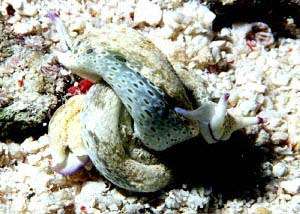
Dear Bill,
Here is a photo of Placobranchus ocellatus, [Panglao Is., Philippines, Nov 1998] shortly before mating. They met and hurried fast around one another, forming the shown knot.
By the way should the spelling be Placobranchus or Plakobranchus?
Erwin
E.Koehler@deutschepost.de
Koehler, E., 1998 (Dec 30) Placobranchus mating behaviour. [Message in] Sea Slug Forum. Australian Museum, Sydney. Available from http://www.seaslugforum.net/find/427Thanks Erwin,
Anyone else with observations on Placobranchus mating like this?
Concerning the spelling. My understanding is that Bergh introduced the spelling "Plakobranchus" in 1871, 50 years after van Hasselt used "Placobranchus". While there may be good grammatical grounds for changing the spelling to "Plak-" it seems to me that such pedantry should not be allowed to overrule the basic Rule of Nomenclature that most of us follow, that the first spelling should be retained wherever possible. I see no good reason why Plakobranchus should replace the original and usual spelling "Placobranchus". Any views or arguments welcome.
Rudman, W.B., 1998 (Dec 30). Comment on Placobranchus mating behaviour by Erwin Koehler. [Message in] Sea Slug Forum. Australian Museum, Sydney. Available from http://www.seaslugforum.net/find/427